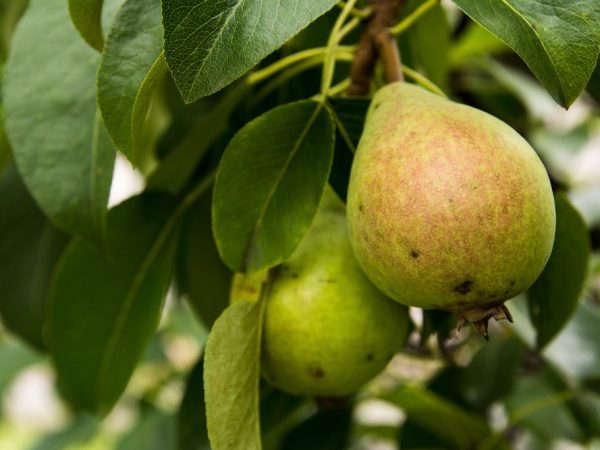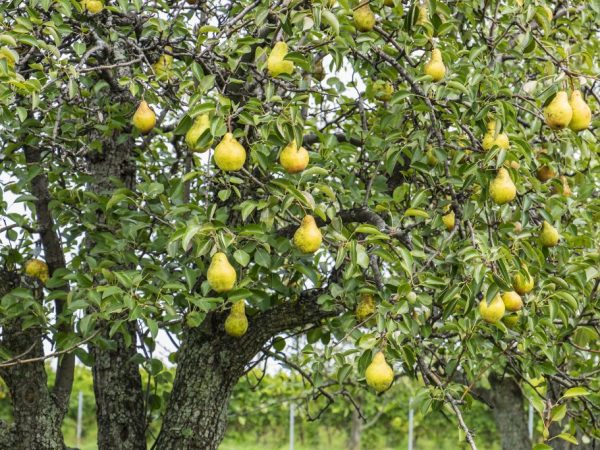Characteristics of the pear variety Belorusskaya Late
Pear Belorusskaya late - a variety that was bred in the 1980s at the Belarusian Institute of Fruit Growing. Another name for gruushi is Winter Belarusian late.

Characteristics of the pear variety Belorusskaya Late
Belorusskaya late has qualities that distinguish it from other varieties of pears. This pear has many positive traits.
Variety characteristic
The Belarusian late pear has a very good characteristic. The plant is not demanding on growing conditions.
Description of the tree
The tree is medium-sized, the height reaches 4 m. The crown reaches 3 m in volume. The main branches grow from the trunk at a right angle, they are directed upwards. The tree gives its first fruits in 3.5 years. The shoots are medium in thickness, rounded in cross section, brown in color and completely covered with pile. Lentils are small and there are many of them. The leaves are small, oval in shape, the edges have round serrations. Foliage of light shades of green. The flowers are large, the petals are oval and white. The tree is self-fertile.
The winter season is not terrible for the tree because of its high resistance to cold weather.
Description of fruits
Fruits are medium in size. Weight reaches 125 grams. Rounded shape. The peel is thin, rough. A fully ripe, ripe fruit has orange and yellow colors. The seeds are small, brown in color. The late Belarusian pear has a positive description of the taste: the pulp is white, juicy, soft and sweet with a bit of sourness. Fruits contain beneficial vitamins, such as vitamin C, which improves human immunity. Pears of this variety can be used to prepare juices, compotes, preserves and dried fruits.

The fruits of a pear are round in shape, medium in size, weighing up to 125 g
Care
There are rules for caring for this variety. If you do not adhere to them, then there will be problems in the growing process.
Soil preparation and planting
Prepare the soil before planting. In advance, you should dig up all the soil in the area where the tree will grow. While the digging process is in progress, remove weeds, debris and debris from other plants. Next, you need to prepare a planting pit, which would be good to fertilize in advance. Wood ash with water (1 liter of water per 200 grams of ash) is suitable as a fertilizer for the pit. After the procedures listed above, you can start planting seedlings. The root tip should look out of the soil at a level of 6 cm. Also, when any plant with an open root system is buried, most of the leaves will need to be removed.
Care after landing
After planting, the tree should be watered once a week. Top dressing is a good way to help your plant grow better. For fertilization, it is recommended to use a solution of urea (20-30 g of urea per 1 liter of water). You can fertilize a pear no more than three times a month. At the beginning of March, you need to trim the leaves. In the process of tree growth, it is required to monitor the general condition (whether there are pests, diseases, weeds).
Diseases and pests
The appearance of diseases or pests is completely normal. This problem can be easily corrected if it was noticed at the time.
Diseases
In the early stages of the disease, there is every chance to save the plant. If the disease was not noticed in time, then you will have to get rid of the whole plant, since the treatment is already useless.
- Pear scab. The disease appears due to the fungus that is in the soil. Due to the disease, light spots appear on the leaves. The fruit is covered with a dark coating, rotten cracks appear. To cure the disease, it is necessary to treat the tree with a solution of fungicides and water (20 grams of fungicide per 1 liter of water).
- Fruit rot. The disease appears due to the fungus Monillosis. Due to this disease, the fruits lose their taste, become covered with fungal growths and fall off. For treatment, you need to remove diseased fruits and treat the tree with a solution of milk of lime and water (100 grams of milk of lime per 1 liter of water).
- Sooty fungus. The disease causes blackening of the leaves. This is a fungal disease. Best of all, the Calypso insecticide will cope with this disease.
- Black pear cancer. This disease affects the very stem of the plant. Dark spots appear on it and it cracks. The holes formed will rot. To cure a tree from black cancer, you need to remove the infected parts of the bark and treat the cracks with copper sulfate. The crack should be covered with clay.
- Cytosporosis. Cytosporosis appears due to the fungus Cytospor. The bark is covered with brown ulcers in the affected area. Usually, the disease appears if a sunburn has been produced. For treatment, it is necessary to cut off the diseased part of the bark, process the incision with copper sulfate and glue it with clay.

In the early stages of the disease, there is every chance to save the plant.
Pests
The most common harmful insects of this variety:
- Leafy gall midge. The leaf gall midge is a midge that looks like a very small red mosquito. This midge can fly over fairly long distances. The very danger is caused by their stage of reproduction, because it is the larvae of the leaf gall midge that harm the plant. These larvae eat the leaves of the tree. As a result, the leaves crumble, turn yellow, become lethargic. To combat them, you need to spray the tree with insecticides.
- Medianitsa. The honeydew is a winged insect, yellow in color and no more than 3 mm long. This parasite lays its eggs on the buds of the plant. Larvae appear along with bud break. The larvae eat the opened buds. Their activity spoils the fruits, because of them leaves fall, and the development of buds stops. It is necessary to hatch the larvae of Medianitsa with insecticides.
- Fruit gall midge. The insect looks like a Leaf gall midge in appearance, only several times larger. She leaves her larvae in the soil. The activity of their larvae spoils the fruit, leaves growths. It is best to use insecticides to remove this pest.
- Fruit moth. The moth is an insect that looks like a small moth, dark gray in color with brown spots. This parasite lays its eggs in the topsoil. Caterpillars that emerge from eggs penetrate and feed on fruits. To defeat this pest, you need to dig the soil near the tree and treat everything with insecticides.
- Gall mite. Gall mite is a very small and red mite. It feeds on leaves, lays eggs in the buds. After its activity, the leaves acquire brown ulcers and fall off. The recommended remedy for the fight is a solution of colloidal sulfur and water (a tablespoon of colloidal sulfur per 1 liter of water).
Pests can easily move from one plant to another. That is why you need to check nearby plants for parasites.
All insects reproduce rather quickly. It is important to notice the first appearance of pests on plants.
Conclusion
The pear variety Belorusskaya Late fully deserves the attention of gardeners. The taste of its fruits will be loved by many, and even a beginner can grow such a pear.Our recommendations will help you get an excellent harvest of this pear variety.


